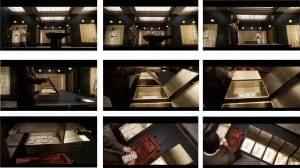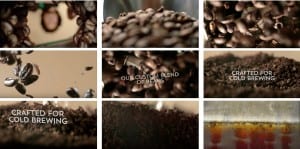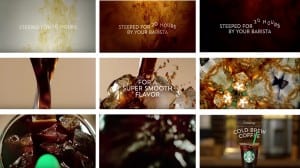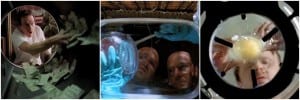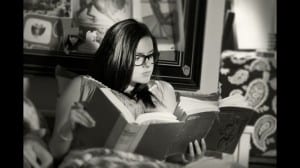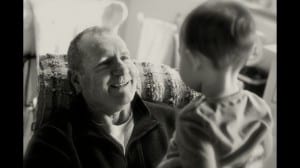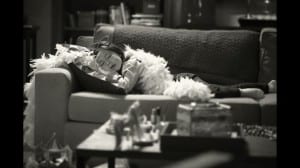Spielberg – Munich (2005)
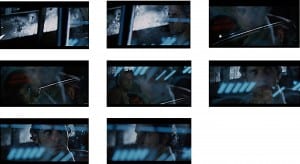 Window reflection shot – we see a car pull up with the driver (this is in focus). The camera focus changes to the man watching in a different car. As one of the other men in the other car gets out, the camera focus goes back to the man we saw first. This is one long continuous shot.
Window reflection shot – we see a car pull up with the driver (this is in focus). The camera focus changes to the man watching in a different car. As one of the other men in the other car gets out, the camera focus goes back to the man we saw first. This is one long continuous shot.
Above are screenshots from the scene in the bank. This scene starts with a wide angle shot, which is low down, looking up at the actors. As the actors start walking towards the table, the camera starts to zoom in, this then develops into a tracking shot. The camera then zooms out and transitions into an over the shoulder shot.
Introducing Starbucks® Cold Brew Coffee
Research – Filming with a GoPro
Filming with a GoPro, different camera angles and perspectives for shooting outside
Looking at different camera angles and perspectives for shooting with a GoPro

This video was shot in time lapse. Shooting in time lapse helps to show how busy the city is on a day to day basis. Filming on location can be challenging as you cannot control the lighting/weather. Having the camera move around to different places of the city gives a new perspective of the city as they have captured what goes on in different parts of the city, all in one day.
A film about Coffee
 A Film About Coffee is a love letter to, and meditation on, specialty coffee. It examines what it takes, and what it means, for coffee to be defined as “specialty.” The film whisks audiences on a trip around the world, from farms in Honduras and Rwanda to coffee shops in Tokyo, Portland, Seattle, San Francisco and New York. Through the eyes and experiences of farmers and baristas, the film offers a unique overview of all the elements—the processes, preferences and preparations; traditions old and new—that come together to create the best cups. This is a film that bridges gaps both intellectual and geographical, evoking flavor and pleasure, and providing both as well.
A Film About Coffee is a love letter to, and meditation on, specialty coffee. It examines what it takes, and what it means, for coffee to be defined as “specialty.” The film whisks audiences on a trip around the world, from farms in Honduras and Rwanda to coffee shops in Tokyo, Portland, Seattle, San Francisco and New York. Through the eyes and experiences of farmers and baristas, the film offers a unique overview of all the elements—the processes, preferences and preparations; traditions old and new—that come together to create the best cups. This is a film that bridges gaps both intellectual and geographical, evoking flavor and pleasure, and providing both as well.
– http://afilmaboutcoffee.com/
‘No matter the quality of your cup, people who love coffee, love it. Coffee is about people, and people are what I’m interested in ultimately.’
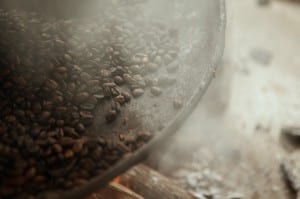 Brandon Loper, Director
Brandon Loper, Director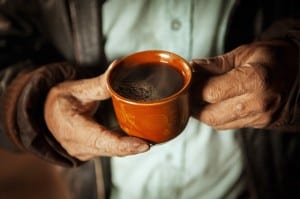
Philip Clemo
Since late 2013, Clemo has been working on The Breath Project, encompassing a feature film and art installation produced by perfectmotion and Animal Monday. Breath illustrates the dramas of human life through the metaphor of landscape, from isolation and turmoil to exhilaration and transformation. Moving through the seven phases of human life, through ageing human forms and across different terrains of the human body, we see comparisons with the environments of planet Earth
-http://arch-pictures.co.uk/sample-page/films-to-watch-out-for/
Michael Moore
Michael Francis Moore is an American documentary filmmaker, screenwriter, author, journalist, actor, and left-wing political activist.
‘Filmmaker Michael Moore explores the roots of America’s predilection for gun violence.’
There are a variety of different camera angles used throughout this film, for example, one camera position is quite low down looking up at the person being interviewed, this then makes the interviewee look more powerful. In the scene where he interviews Marilyn Manson, the camera angle is level with him.
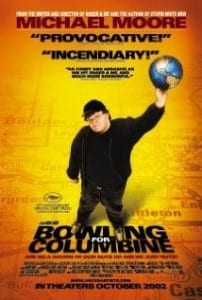
By interviewing parents of the children that were killed, as an audience we have an emotional response as we can see how it has effected the lives of different families involved with the attack.
Overall this is a powerful documentary, as it shows us that this will keep happening in schools, especially in America if they do not change the law and keep an eye out for the dangerous effect the freedom of having guns and playing violent video games has on young adults and teenagers.
‘Sound is more important than picture. Pay your sound woman or sound man the same as you pay the DP, especially now with documentaries. Sound carries the story.’
Breaking Bad
It wouldn’t be an episode of “Breaking Bad” without a clever shot from the perspective of some unlikely inanimate object, and in this episode the honor went to the gas can Jesse hauled to Walt’s house after discovering his former mentor’s treachery in the Brock incident. Slovis said he prefers to use such shots sparingly, but in this case the choice was obvious. “To me, that was a very important shot for a lot of reasons,” he said. “Not because it was cool. But if you missed what he was grabbing or you didn’t really register, right smack in front of you, in great big letters, it says, “DANGER GASOLINE” — filling the frame with a little Jesse on top. And it’s red! So to me, that made total sense.”
“Breaking Bad” may be the most meticulously constructed TV show ever, but at the end of the day it’s still a TV show. As Slovis put it, “We do the best that we can to create art, but the truth of the matter is, unlike movies, we are just damn lucky to get the whole thing into the can in the time that we’re given with the money that we’re given.” – http://www.huffingtonpost.com/2013/08/30/breaking-bad-secrets_n_3843027.html
Coffee 101: Behind the Buzz
- Variety of close up shots, showing different types of coffees being made, in different cafes
- A cheap luxury
- A cultural experience
- Interviews with a variety pf different people
- Archive footage used of people collecting the beans and drinking cups of coffee
- There is no social class for drinking coffee, it doesn’t matter where you are from or what you do, you can still enjoy a cup of coffee
- Seem to just use artificial lights already in the cafes and daylight from the windows
- Talk a little bit about the history of coffee and how its grown to such a popular everyday occurrence
- A bit of background music used throughout but not obvious, quite subtle

Modern Family
Season 5, episode 14
The ending scene of this episode has stills in black and white that appear on the screen, with subtle music in the background to accompany them. I like the way that the scene is edited together, as it is simple but more effective as you appreciate the photos a lot more.
Memento – Film Research
Memento, 2000. Mystery/Thriller, Directed by Christopher Nolan.
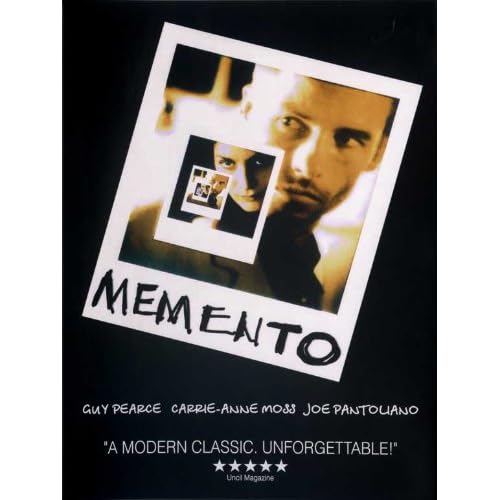
Memento chronicles two separate stories of Leonard, an ex-insurance investigator who can no longer build new memories, as he attempts to find the murderer of his wife, which is the last thing he remembers. One story line moves forward in time while the other tells the story backwards revealing more each time. (Written by Scion013 – http://www.imdb.com/title/tt0209144/?ref_=nv_sr_1)
Stylistic approach
In the video below, at point 5:44, the film is in black and white and the main character Leonard is developing a polaroid. As the polaroid starts to develop and turns into a coloured image, so does the rest of the film. This is a very subtle transition, you almost don’t notice it at first. I also feel that overall the film is very well lit, especially in the scene below, as it is quite dark with limited lighting it helps to add to the mystery of the film/subject matter.
The Lumiere Brothers
By early 1895, the brothers had invented their own device combining camera with printer and projector and called it the Cinématographe.
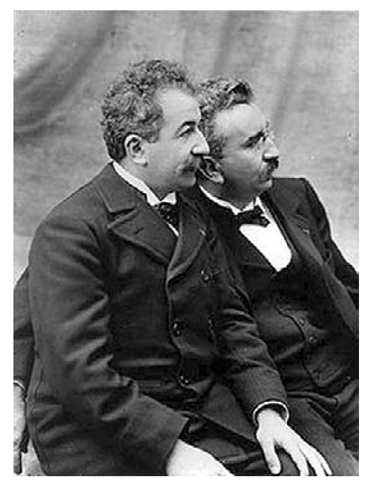
The Lumières brothers shot their films at 16 frames per second.
One of their first film screenings was on 22nd March 1895 at 44 Rue de Rennes in Paris at an industrial meeting where a film especially for the occasion, Workers leaving the Lumière factory, was shown.
In the scene above you can see that the Lumiere brothers were one of the first filmmakers to document people on a day to day basis, completing their daily tasks. This films shows members of the public waiting on the platform for the train approaching the station.
